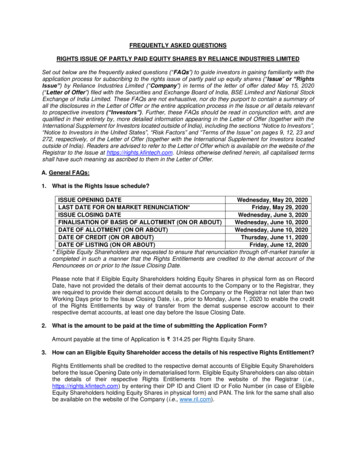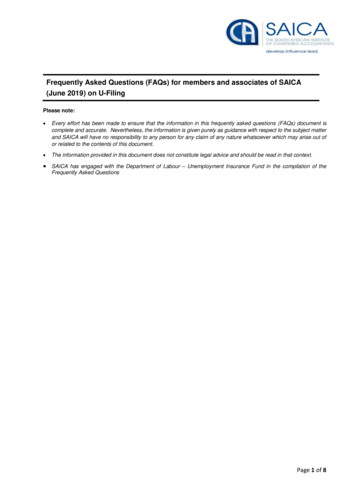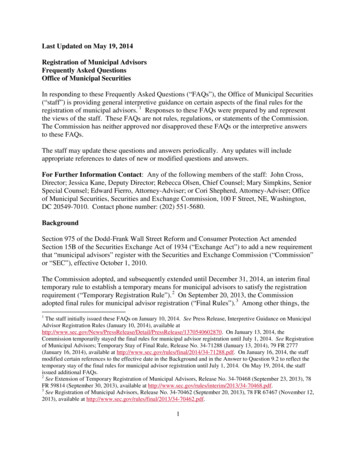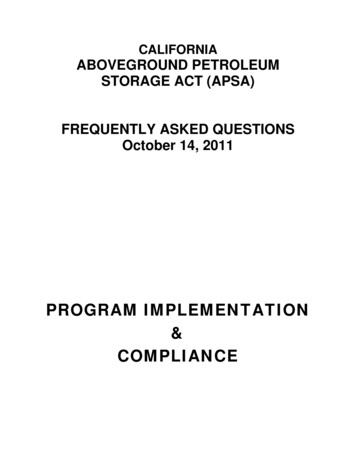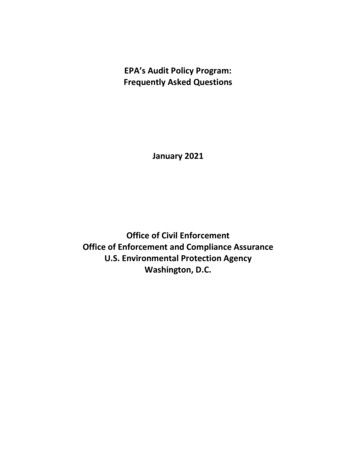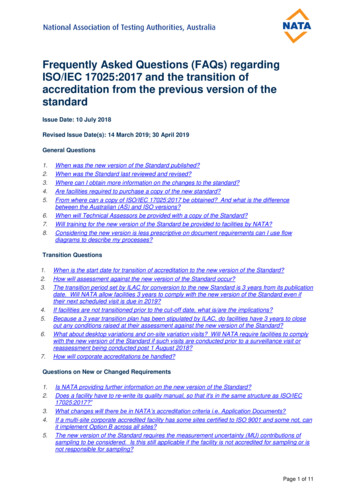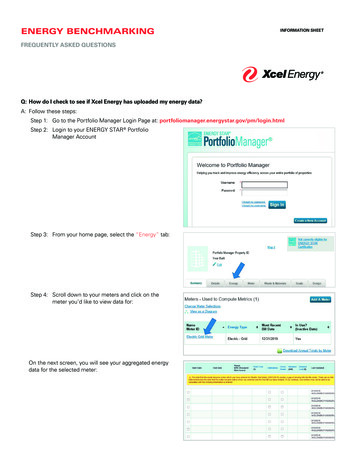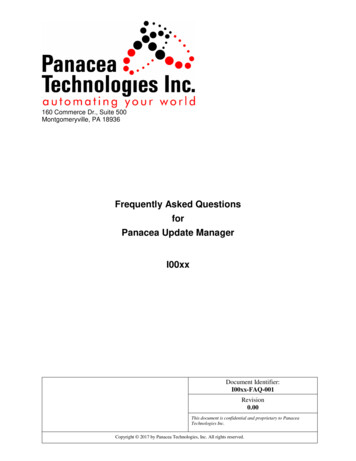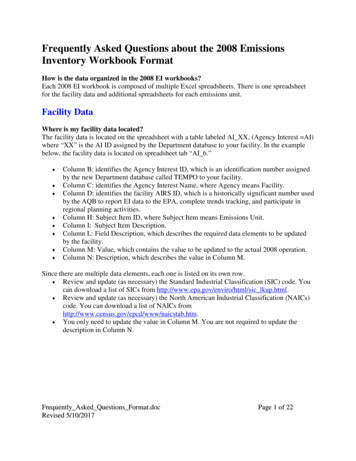
Transcription
Frequently Asked Questions about the 2008 EmissionsInventory Workbook FormatHow is the data organized in the 2008 EI workbooks?Each 2008 EI workbook is composed of multiple Excel spreadsheets. There is one spreadsheetfor the facility data and additional spreadsheets for each emissions unit.Facility DataWhere is my facility data located?The facility data is located on the spreadsheet with a table labeled AI XX, (Agency Interest AI)where “XX” is the AI ID assigned by the Department database to your facility. In the examplebelow, the facility data is located on spreadsheet tab “AI 6.” Column B: identifies the Agency Interest ID, which is an identification number assignedby the new Department database called TEMPO to your facility.Column C: identifies the Agency Interest Name, where Agency means Facility.Column D: identifies the facility AIRS ID, which is a historically significant number usedby the AQB to report EI data to the EPA, complete trends tracking, and participate inregional planning activities.Column H: Subject Item ID, where Subject Item means Emissions Unit.Column I: Subject Item Description.Column L: Field Description, which describes the required data elements to be updatedby the facility.Column M: Value, which contains the value to be updated to the actual 2008 operation.Column N: Description, which describes the value in Column M.Since there are multiple data elements, each one is listed on its own row. Review and update (as necessary) the Standard Industrial Classification (SIC) code. Youcan download a list of SICs from http://www.epa.gov/enviro/html/sic lkup.html. Review and update (as necessary) the North American Industrial Classification (NAICs)code. You can download a list of NAICs fromhttp://www.census.gov/epcd/www/naicstab.htm. You only need to update the value in Column M. You are not required to update thedescription in Column N.Frequently Asked Questions Format.docRevised 5/10/2017Page 1 of 22
Why are Columns A, E-G, J, and K hidden?These columns hold data necessary for the EI data export and import procedures for TEMPO.Please do not change these fields in any way. If you do, you may make the electronic uploadinoperable.Equipment DataWhere is my equipment data located?Each emissions unit is displayed on its own spreadsheet.Some of my equipment spreadsheet tabs have different names. What is the differencebetween ACT, AREA, CONT, EQPT, and RPNT? An activity (ACT) is the act of doing or processing something that we regulate. Anexample would be "Asbestos Removal." An area (AREA) is the location of doing or processing something that we regulate. Anexample would be "Raw Material Pile." A control device (CONT) is a control device that acts to control multiple pieces ofequipment. An example would be an “Emergency Flare” to which multiple emissionsunits vent. Equipment (EQPT) is the actual unit doing or processing something that we regulate. Anexample would be "Internal Combustion Engine." A release point (RPNT) is the location of a fugitive source. An example would be “PlantLevel Fugitives.”Frequently Asked Questions Format.docRevised 5/10/2017Page 2 of 22
What are the purposes of Columns B, C, D, H, I, L, M, N, and I? Column B: identifies the Agency Interest ID, which is an identification number assignedby the new Department database called TEMPO to your facility. Column C: identifies the Agency Interest Name, where Agency means Facility. Column D: identifies the facility AIRS ID, which is a historically significant number usedby the AQB to report EI data to the EPA, complete trends tracking, and participate inregional planning activities. Column H: Subject Item ID, where Subject Item means Emissions Unit. Column I: Subject Item Description. Column L: Field Description, which describes the required data elements to be updatedby the facility for 2008 operations. Column M: Value, which contains the value to be updated to the actual 2008 operationrates. Column N: Description, which describes the value in Column M.Frequently Asked Questions Format.docRevised 5/10/2017Page 3 of 22
Additional Instructions for Reporting Carbon Dioxide Emissions: Emission reports shall include actual emissions of fugitive emissions andemissions occurring during maintenance, start-ups, shutdowns, upsets, anddowntime.Please use the emission calculation procedures located at the following s/NM GHGEI quantif proced2008.pdfReport only combustion, and vented (if, applicable) carbon dioxide emissionsfrom your facility.For each subject item enter the actual amount of CO2 emissions in tons per year(e.g. combustion CO2 for a combustion source or vented CO2 for a ventedsource).Report fuel carbon content of each fuel type used by the facility.Include carbon dioxide emissions occurring during maintenance, start-ups,shutdowns and upsets.Use the appropriate calculation code to cross reference between the spreadsheetand the emission calculation methods found in our GHG reporting procedures.Create a separate Excel workbook and provide emission calculation example(s)for each unique subject item type at your facility (e.g. engine, flare, amine unit orturbine). Submit this workbook in conjunction with your 2008 EmissionsInventory workbook.Owners or Operators reporting pursuant to 20.2.87 Greenhouse Gas EmissionsReporting shall provide a listing, including percentages, of the owners of equityshares of the emissions reported, and shall submit their reports no later than July1, 2009.How do I update the 2008 EI workbook for fuel burning equipment?Please only update Columns M and N. Follow the steps below: Update Column M for Actual Percent of Operation Duringo Winter,o Spring,o Summer, ando Fall.o The total for all four seasons should not exceed 100%. Update Column M for Actual Operating Time ino Hours Per Day – no more than 24o Days Per Week – no more than 7o Weeks Per Year – no more than 52o Hours Per Year – no more than 8760 for 2008o Report only whole number values.Frequently Asked Questions Format.docRevised 5/10/2017Page 4 of 22
Update Column M for fuel consumptiono Actual Fuel ConsumptionFuel typeCoalDieselNatural Gaso Actual Fuel Heating ValueFuel typeCoalDieselNatural GasUnitsM tons/yM gal/yMM SCF/yUnitsMM BTU/M tonMM BTU/M galMM BTU/MM SCFo Actual Fuel Type - enter the Material code from the NIF version 3 Materialspreadsheet, which is copied below. Also update the description from the sametable, if necessary.o Actual Percent Sulfur of Fuelo Actual Percent Ash of Fuel Update Column N for Actual Input Materials Processedo For Fuel burning equipment, the Actual Input Materials Processed will be thesame as Actual Fuel Type.o Enter the description from Actual Fuel Type Column N into the Actual InputMaterials Processed Column N. Update Column M Standard Classification (SCC) Codeo SCCs may be downloaded fromhttp://www.epa.gov/ttn/chief/codes/index.html - sic Update Column M for actual emissions in tons per year. Update Column M for calculation method.o Use the codes below for calculation method code. Note, these are not the same asthose listed in the NIF:Frequently Asked Questions Format.docRevised 5/10/2017Page 5 of 22
CalculationMethod lm11mbmamfprcr06pvrdre131210srtc0814wgCalculation MethodAsphalt Production - 95113(b)(4)(A)Actual Stack TestBottoming Cycle Plant - 95112(b)(4)(B)Compliance TestingContinuous Catalyst regen - 95113(b)(2)(B)Continuous Emissions Monitoring (CEMS)Design CalculationDirect ObservationElectric Acid Gas Scrubbing - 95111(e)Engineering JudgmentEngineer CalculationE & P TanksEPA Emission FactorsEPA Published CriteriaEPA Speciation ProfileEstimateFacility SpecificField MeasurementFlares and Control Devices - 95113(d)GRI-GLYCalc 4.0GRI-HAPCalc 3.0GRI-HAPCalc 4.0Hydrogen Plant – 95114(b)(2)(3)Lab MeasurementManufacturer SpecificationMaterial BalanceMathematical ModelMeasurement Using FactorOther Publication ReferencePeriodic Catalyst Regeneration – 95113(b)(2)(A)Process SimulatorProcess Vents – 95113(b)(3)(A)Radiation DoseRadiation ExposureSite-Specific Emission FactorState/Local Emission FactorState/Local Speciation ProfileSulfur Recovery – 95113(b)(5)(A)Topping Cycle Plant – 95112(b)(4)(A)Trade Group Emission FactorVendor Emission FactorVasquez BeggsFrequently Asked Questions Format.docRevised 5/10/2017GHG 5125(c)95125(a)API 5.1.4Page 6 of 22
Update Column M for control efficiency if there are control equipmento If the emissions unit is Uncontrolled, then Column M will be blank.o If the emissions unit is controlled, then the control device will be identified andColumn M will contain the control efficiency in percent.How do I update the 2008 EI workbook for tanks?Update the spreadsheet as outlined above with the following exceptions: Update the tank throughput in either thousand gallons per year (M Gal/Y) or barrels peryear (BBL/Y)o Update value in Column M - Actual Fuel Consumptiono Even though the tank does not in fact consume fuel, this field also accommodatesthroughput values Update the Column N for Actual Input Materials Processedo Use the NIF Version 3.0 Material spreadsheet descriptions (attached at end ofdocument).How do I update the 2008 EI workbook for fugitive sources?Update the spreadsheet as outlined above with the following exceptions: There will be no reportable values for fuel consumption or materials processed Update all other fields.How do I update the 2008 EI workbook for landfills?Update the spreadsheet as outlined above with the following exceptions: There will be no reportable values for fuel consumption.o Update Actual Input Materials Processed Column N (attached at end ofdocument). Update all other fields.Frequently Asked Questions Format.docRevised 5/10/2017Page 7 of 22
NIF Version 3 Code Table for MaterialMATERIAL Butene7671-Pentene611100% Sulfur612100% Sulfuric Acid7682,4-Dichlorophenol7692-Butene8753/4-inch Medium Density Fiberboard7713/4-inch Particleboard7703/8-inch Oriented Strand Board6143/8-inch Plywood77237% Formaldehyde Solution615Abrasive973ABS Polymer773Acetaldehyde774Acetic Acid775Acetic cid619Acrolein777Acrylic Acid778Acrylic Esters621Acrylonitrile622Adhesive623Adipic Acid779Adipic Acid d Bleached Pulp627Air-Dried Unbleached Pulp628Alcohol780Aldehyde781Alkane782Alkene783Alk yne970Alloy784Allyl AlcoholFrequently Asked Questions Format.docRevised 5/10/2017Page 8 of 22
59660661796663664395667668669670671Allyl ChlorideAluminaAluminumAmineAmmoniaAmmonium BicarbonateAmmonium NitrateAmmonium SulfateAnhydrideAnhydrous AmmoniaAnhydrous HydrazineAnilineAnthraciteAnthracite CulmApplianceAqueous AmmoniaAreaArea Pesticide AppliedArea Sludge AppliedAromaticAsbestosAshAsphaltAsphalt Shingles/RollsAsphaltic ConcreteAverage AirflowBagasseBarkBatch of BottlesBatteriesBauxite MaterialBeaded GlassBeansBeerBentoniteBenzeneBenzyl ChlorideBituminous CoalBituminous/Subbituminous CoalBlack Liquor SolidsBlastBoardBoatBodyBottlesFrequently Asked Questions Format.docRevised 5/10/2017Page 9 of 22
ozerBullionButadieneButaneButyl AcetateButyl AcrylateButyl CarbitolButyl CellosolveCansCaprolactum (Soln)CarbitolCarbon BlackCarbon DioxideCarbon DisulfideCarbon MonoxideCarbon TetrachlorideCarboxylic AcidCarpetCaseinCast ChargeChickenChipsChlorineChloroacetic AcidChlorobenzeneChlorofluorocarbon 12/11ChloroformChloropreneChlorosolveChromic AcidCircuit BoardsClayClinkerClothesCoalCoal Storage AreaFrequently Asked Questions Format.docRevised 5/10/2017Page 10 of 22
348133581481536816817384042Coal TarCoatingCoating LineCoating MaterialCoating MixCokeCoke Oven GasCoke Oven or Blast Furnace GasCoke-Free ChargeCold CleanerConcentrateConcentrated OreConcreteCondensateConstruction ActivityContainersCoolantCooling W aterCopper SulfateCore OilCoresCornCorn Gluten FeedCorn Gluten MealCottonCottonseedCreosoteCresolCropsCrude GypsumCrude OilCrude OreCrude Terephthalic AcidCrushed rDextroseFrequently Asked Questions Format.docRevised 5/10/2017Page 11 of 22
ne GlycolDigester GasDiisopropyl BenzeneDimethyl SulfoxideDimethylamineDimethylformamideDipropylene GlycolDistillateDistillate OilDistillate Oil (Diesel)Distillate Oil (No. 1 & 2)Distillate Oil (No. 1)Distillate Oil (No. 2)Distillate Oil (No. 4)DodeceneDrainDried BeansDried Blood MealDried GermDried GrainDried HullsDried MaltDried MaterialDried SludgeDried TalcDried YeastDrumDry MaterialDry NaHCO3Dry ProductDry SawdustDryer FeedDual Fuel (Gas/Oil)DyeDyes/PigmentsEAF rinEquipmentFrequently Asked Questions Format.docRevised 5/10/2017Page 12 of 22
113114115116839117EsterEtching yl AcetateEthyl AcrylateEthyl BenzeneEthyl ChlorideEthyl EtherEthyl MercaptanEthylbenzene/StyreneEthyleneEthylene DibromideEthylene DichlorideEthylene Dichloride-VCEthylene GlycolEthylene OxideEthyleneaminesEthylenediamineExhaust GasExposed AreaExtractor Feed CakeFabricFacilityFeedFeed MaterialFermented JuiceFertilizerFiberField CropsField W eightFinal AcidFinished PelletFinished ProductFireFired CeramicFishFish MealFish ScrapFlangeFloor AreaFlue DustFrequently Asked Questions Format.docRevised 5/10/2017Page 13 of 22
arFluosilicic AcidForest ResiduesForestsFormaldehydeFormalinFormic AcidFreonFresh FeedFuelGasGasolineGlassGlazeGlycerolGlycolGlycol EthersGraderGrainGravelGray IronGreen BeansGritGum TurpentineHalogenated OrganicHamburgerHeadHead of CattleHeatHeavy W aterHeptenesHexachlorobenzeneHexamineHoleHot MetalHot Mix AsphaltHydrated LimeHydrazine HydrateHydrochloric AcidHydrofluoric AcidHydrogenHydrogen ChlorideHydrogen CyanideHydrogen FluorideFrequently Asked Questions Format.docRevised 5/10/2017Page 14 of 22
73174175867868869870177178179180181Hydrogen SulfideInkInstant CoffeeIronIsobutyl AcrylateIsobutyl olIsopropyl AcetateItemJet A FuelJet FuelJet KeroseneJet NaphthaKeroseneKetoneLampLandLandfillLandfill GasLanding-Takeoff CycleLeadLead in OreLead OxideLead ProductLeavesLightning StrikeLigniteLimeLimestoneLinear Alk ylbenzeneLiquidLiquid AmmoniaLiquid PropellantLiquid W asteLiquified Petroleum Gas (LPG)LiquorLogsLube OilFrequently Asked Questions Format.docRevised 5/10/2017Page 15 of 22
leneMake-Up SolventMakeupMaleic AnhydrideMaltMalted GrainMaterialMDIMealMeatMedical W asteMercaptanMercuryMetalMethaneMethanolMethyl AcetateMethyl AcrylateMethyl Am yl KetoneMethyl CarbitolMethyl CellosolveMethyl ChlorideMethyl Ethyl KetoneMethyl Isobutyl KetoneMethyl IsocyanateMethyl MercaptanMethyl MethacrylateMethyl StyreneMethyl-tert-Butyl EtherMethylalleneMethylamineMethylene ChlorideMixing MaterialMolten AluminumMonoethanolamineMonomern-Butyl -Hexanen-Pentanen-Propyl AcetateFrequently Asked Questions Format.docRevised 5/10/2017Page 16 of 22
90906987986233907762908909910911234n-Propyl AlcoholNaphthaNaphthaleneNatural GasNatural Gas LiquidsNeopreneNitric neOilOlefinOrchard CropsOrchard HeaterOreOven-dried W orophenolPentadecanePerc & Carbon TetrachloridePerc & TrichloroethylenePerchloroethylenePerchloromethyl MercaptanPersonPetroleum DistillatePetroleum LiquidPhenolPhosgenePhosphateFrequently Asked Questions Format.docRevised 5/10/2017Page 17 of 22
49262263265266981267268269551270272Phosphate RockPhosphoric AcidPhosphorousPhotoresistPhthalic AnhydridePiecesPig nated biphenylsPolycyclic organic matterPolyester/Alk yd ResinPolyethylene GlycolPolyvinyl ChloridePotassium ChloridePressed W et PulpPrimerPrinting LineProcess GasProcess UnitProduced W aterProductProduct Surface AreaPropanePropane/ButanePropionaldehydePropionic AcidPropylenePropylene GlycolPropylene OxidePulpPure AcidPure SolventRaw BeetsRaw CokeRaw FishRaw JuiceRaw MaterialRaw SeedRayonReclaimed SolventRefined OilFrequently Asked Questions Format.docRevised 5/10/2017Page 18 of 22
28303929567304305306307308930952953Refinery Crude FeedRefinery FeedRefinery GasRefuseRefuse Derived FuelRegenerated AdsorbentResidual OilResidual Oil (No. 5)Residual Oil (No. 6)Residual/Crude OilResidues/SkimmingsResinResin or W axRockSaltSandSaturated FeltSawdustScrapScraperSealSealersec-Butyl AlcoholSewage Grease SkimmingsShinglesShotSilicomanganeseSinterSlab ZincSlagSlipSludgeSodium BicarbonateSodium CarbonateSoilSolid PropellantSolid W asteSolutionSolventSolvent in CoatingSolvent in Drawing CompoundSolvent in InkSolvent/W aterSolvents: AllSolvents: NECFrequently Asked Questions Format.docRevised 5/10/2017Page 19 of 22
44345347348349350352933353354355357Sour GasSoybean MealSoybeansSpecial NaphthasSpecialty ChemicalSpecialty SteelSprayed MetalStarchStarting MonomerSteamSteelStockStoneStorage AreaStorage PileStorage TankStyreneStyrene-Butadiene RubberSubbituminous CoalSugarSulfurSulfur DioxideSulfuric AcidSump AreaSurface AreaSyrupTalcTank CarTank Trucktert-Butyl AlcoholTetrahydrofuranThick JuiceThin JuiceThinned ResinThinning SolventTileTinTiresTNTTolueneToluene DiisocyanateTonerTopsoilTotal Cargo CapacityTrichloroethyleneFrequently Asked Questions Format.docRevised 5/10/2017Page 20 of 22
5192021946TrichlorotrifluoroethaneTriethylene GlycolTrimethylamineTurpentineUnitUreaVacuum FeedValveVarnishVegetationVehicleVine CropsVinyl AcetateVinyl ChlorideVinylidene ChlorideVOCsW aferboardW afersW afers/ChipsW asteW aste AcidW aste GasW aste LiquidW aste MaterialW aste OilW astewaterW aterW axW eedsW elding RodW ellW et CoalW et Mixed SlurryW hiskeyW ineW oodW ood RefuseW ood W asteW ood/BarkW ood/Vegetation/LeavesW orkX - Ra yXyleneXylenes (Mixed)XylolFrequently Asked Questions Format.docRevised 5/10/2017Page 21 of 22
2223242526272829YeastYeast from F4Yeast from F5Yeast from F6Yeast from F7ZincZinc OreZinc OxideFrequently Asked Questions Format.docRevised 5/10/2017Page 22 of 22
Each 2008 EI workbook is composed of multiple Excel spreadsheets. There is one spreadsheet for the facility data and additional spreadsheets for each emissions unit. Facility Data . Where is my facility data located? The facility data is located on the spreadsheet with a table labeled AI_XX, (Agency Interest AI)


